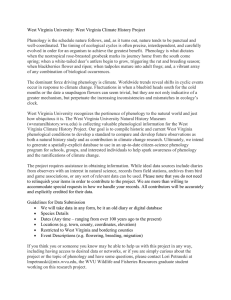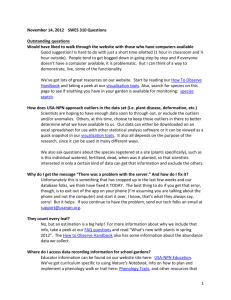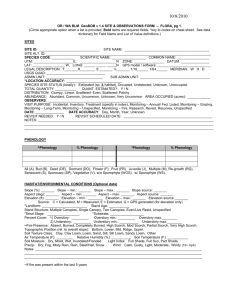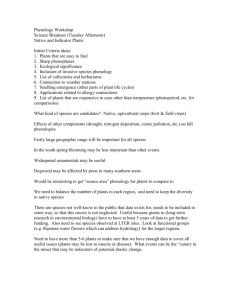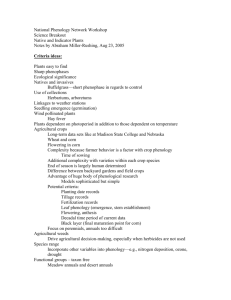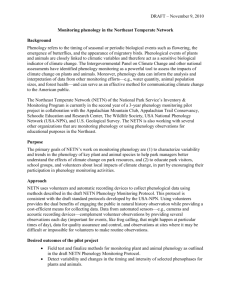12/3/2008 Life cycles, Phenology, and What is Phenology? environmental influences
advertisement
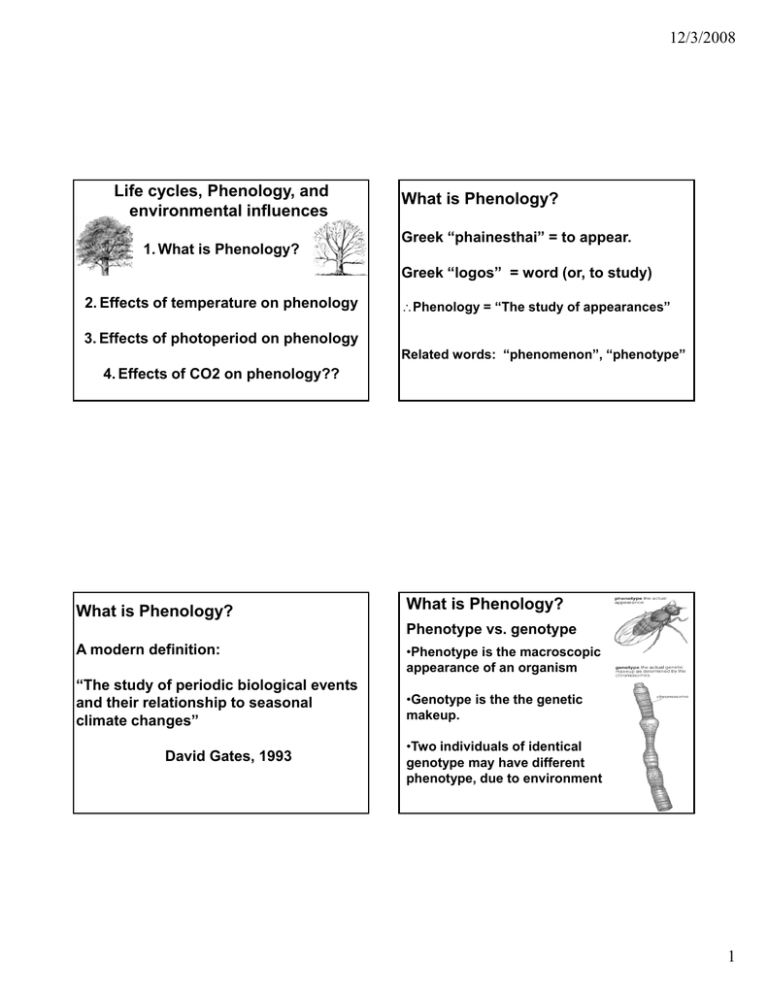
12/3/2008 Life cycles, Phenology, and environmental influences 1. What is Phenology? What is Phenology? Greek “phainesthai” = to appear. Greek “logos” = word (or, to study) 2. Effects of temperature on phenology ∴Phenology = “The study of appearances” 3. Effects of photoperiod on phenology Related words: “phenomenon”, “phenotype” 4. Effects of CO2 on phenology?? What is Phenology? What is Phenology? Phenotype vs. genotype A modern definition: “The study of periodic biological events and their relationship to seasonal climate changes” David Gates, 1993 •Phenotype is the macroscopic appearance of an organism Genotype is the the genetic •Genotype makeup. •Two individuals of identical genotype may have different phenotype, due to environment 1 12/3/2008 What is Phenology? What is Phenology? Covers a broad scope of biological events: Phenology records: g p , Animals: mating/reproduction, fur/shedding, metabolism, migration. Plants: growth, bud initiation/burst, leaf development/senescence, flowering, fruit ripening, seed development Phenological events occur on vastly different time scales depending on lifespan Monks Farmers (e.g. wine harvests) Amateur Naturalists (birders, botanists) Herbarium samples (e.g. Arnold Arboretum) USDA Regional Phenology Network Both heat accumulation and chilling accumulation play roles in determining spring budburst/flowering. Heating accumulation makes intuitive sense in terms of the biochemistry of tissue development and adaptive protection against risky early budburst/flowering. What is the adaptive significance of a chilling requirement? 2 12/3/2008 Effects of temperature on phenology History: Growing Degree Days (GDD; Woodward 1992) = (No. days where Tave >0 0C) x (Tave over that period) Heat accumulation requirement first suggested by Reaumur (1735) René Antoine Ferchault de Réaumur. Effects of temperature on phenology Effects of temperature on phenology Keep in mind: How to incorporate both chilling requirement and heating requirement? There are several different definitions of GDD. Several modeling approaches: Many researchers use 5oC instead of 0oC, others use 10oC 1 Sequential model – chilling requirement satisfied first 1. first, then heating model. (I.e. heating not effective until chilling requirement met) 2. Parallel model – assumes heating model operates simultaneously with chilling model. 3. Alternating Model, Four Phases Model, “deepening rest” model. 3 12/3/2008 Effects of temperature on phenology Crop emergence can be reliably predicted based on GDD. (Water requirement increases with GDD requirement) Effects of temperature on phenology GDD: Indicates that it is the integral of thermal energy, rather than simply threshold or peak temperature, or length of suitable temperatures, that most controls plant phenology. Energy/time = Power Energy x time = momentum x distance ???? (no idea if there is a physical term for this, but maybe there should be) Effects of temperature on phenology Effects of temperature on phenology Hopkins Law: Hopkin’s Law: Andrew Delmar Hopkins (1857-1948) “… the time of occurrence of a given periodical event in life activity in temperate North America is at the general average rate of 4 days to each 1 degree of latitude, latitude 5 degrees of longitude, 400 feet of altitude, later northward, eastward and upward in the spring and early summer, and the reverse in late summer and autumn” Adiabatic lapse rate ~ 0.6oC per 100m altitude (ball park average - varies with humidity) So Hopkin’s Hopkin s law roughly translates into 4 days per ¾ oC change. Hopkins AD (1918) Periodical events and natural laws as guides to agricultural research and practice. US Dept Agric. Monthly Weather Review, Supplement 9 4 12/3/2008 An big lack of understanding, and an opportunity for a significant advance in the science of phenology: “The critical problem with mechanistic phenology p gy models is that the basic biochemistry and biophysics during dormancy is currently unknown” -Chuine, Kramer, Hanninen 2003 Phenology: An Integrative Environmental Science Effects of light on phenology •Plants show daily and seasonal rhythms independent of temperature •Daylength plays a large role in controlling flowering time •Plants ‘determine’ daylength by tracking length of night i ht •Phytochrome (protein pigment) is a substance involved in photoperiodism •Phytochrome likely induces growth or growth inhibiting hormones (e.g. gibberilins or Absisic acid). Lambers et al.: “Vernalization is believed to require perception of low temperature in the vegetative apex. Cold treatment supposedly induces the breakdown of a compound that accumulated during exposure to short days in autumn and which inhibits flower induction; this might be ABA. At the p is produced p that promotes p same time,, a chemical compound flower induction, most likely gibberlic acid.” vernalization n. Subjection of seeds or seedlings to low temperature in order to hasten plant development and flowering. Effects of light on phenology High nighttime sensitivity of phytochrome 5 12/3/2008 Phenology and light: Climate Change Significance. For a given latitude photoperiod does not change, so annual/interannual variability in phenology can’t be caused by photoperiod. However, plants H l t that th t migrate i t across latitudes l tit d will ill experience changing photoperiod. Phenology and elevated CO2 Some research ideas… 800 ppm CO2 increased bud burst by 6 days! 6

